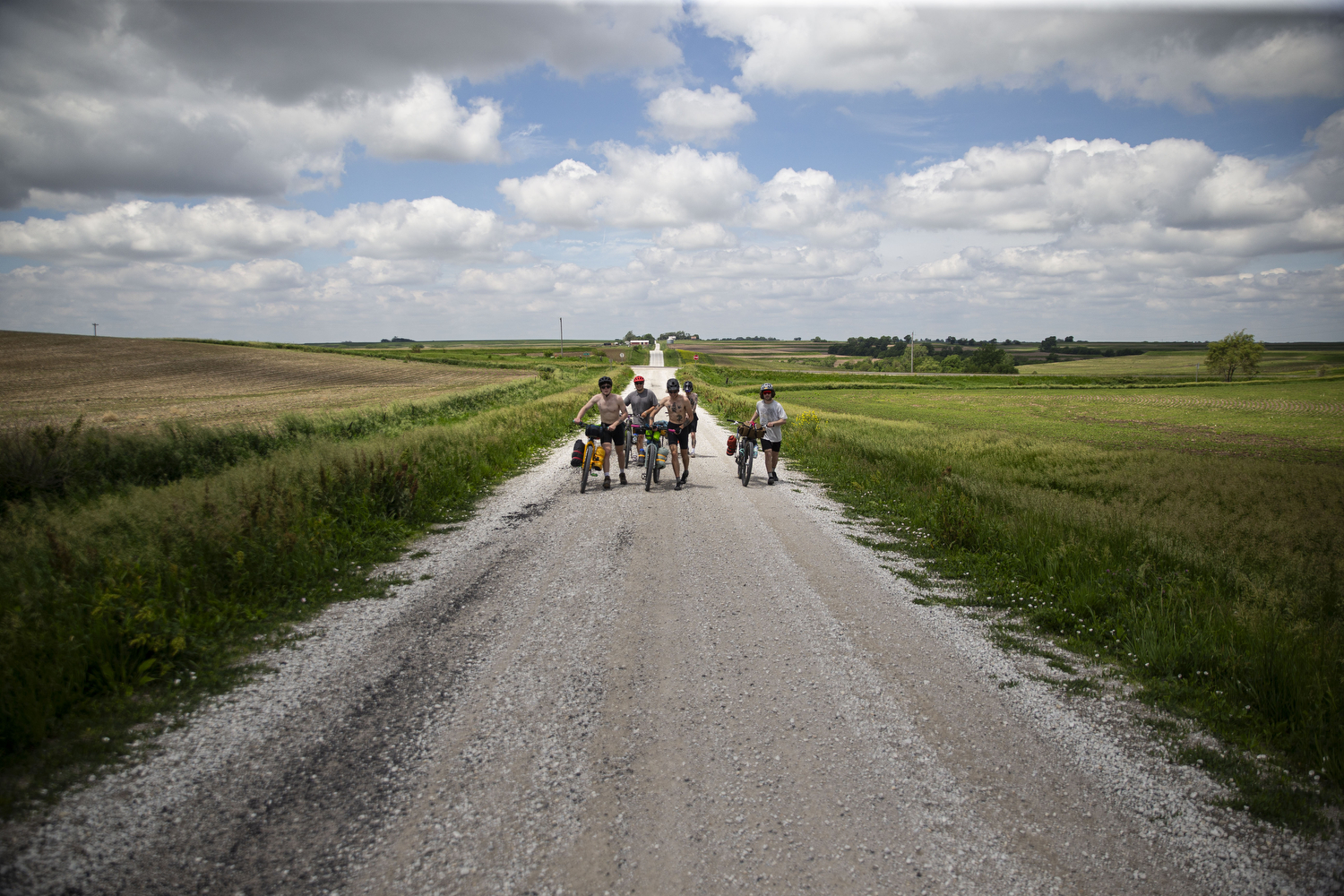Editor’s note: For six days at the beginning of June, The Daily Iowan photojournalist Jordan Barry participated in a bike tour with University of Iowa Art School professor Steve McGuire and his students as they biked from Council Bluffs, Iowa, to Muscatine, Iowa. McGuire and his students rode bikes they put together in his Hand Built Bike classes 490 miles across the state, averaging 83 miles per day, from the Missouri River to the Mississippi River. This piece is written in a first-person perspective to provide a more intimate account of the story.
I’ve always been interested in traveling by bicycle over long distances. I have toured solo by bike in Iowa as well as in the Pacific Northwest, across windy prairies, over steep mountains, and through lush forests. I have found riding a bicycle to be one of the best ways to explore and experience a landscape.
When I found out about the ride across Iowa, I immediately was interested in covering it for The Daily Iowan as I had heard from friends about the legend of Steve McGuire and his classes. McGuire combines aspects of art and engineering in Hand Built Bike I, II, and III while instructing students on how to craft individually unique bicycle frames through a process of designing and welding. McGuire started teaching the course in 2010 with help from frame builder Tom Teesdale after having experience building recumbent tricycles. An avid cyclist and bike enthusiast himself, the 66-year-old said inspiring his students to actually tour with the bicycles they made in his classes is one of the most valuable things he can do as an instructor, relaying that touring by bicycle allows an individual to overcome challenges of both the body and mind.
I was looking forward to documenting the ride but realized developing a bond with McGuire and his students was equally important, if not more, than my job as a journalist. I was first and foremost there to be present and participate in the journey. I had previously never toured with a group before, and I wanted to push the pedals and face the trail head-on like the other students.
Day 1 - Saturday, June 1, 2024
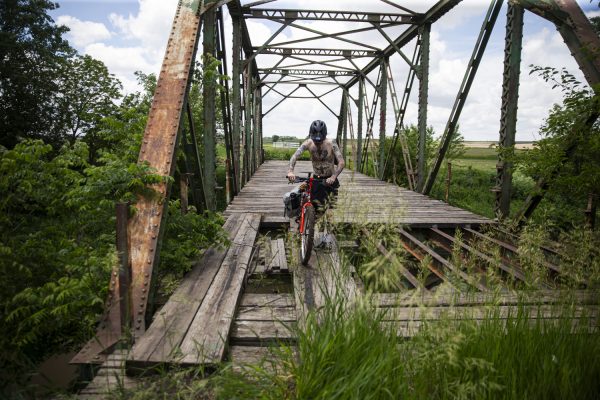
We woke to the buzzing of an alarm in the Western Inn, a small motel outside of Council Bluffs. The reality of the journey ahead loomed in our minds. A grogginess quickly turned to excitement as we ate a breakfast of fresh waffles and stale Raisin Bran in the motel lobby.
The first 20 miles or so we spent heading south on the Wabash Trace Nature Trail, an old rail line converted to a recreation trail in 1997. It’s sheltered for the most part by a lush green canopy. After turning east, we found ourselves on familiar lands of partitioned agriculture under an open sky.
The intensity of the ride increased significantly as we switched from the steady grade of the rail trail to the sharpness of hilly gravel roads. The sun climbed, as did we, with the first drops of sweat falling past our handlebars. Elijah, Ryan, Ben, and Sayre led the pack off and on, stopping every couple of miles to wait for everyone to catch up. Just west of the small town of Red Oak our route had us going on a closed-off B-Road, an unmaintained section of dirt road, which led us toward a bridge in the distance. Upon contemplating taking the B-Road or a gravel detour, Steve weighed in: “Life is either a daring adventure or nothing at all.” We decided to roll the dice.
The B-Road led to a closed-off bridge over a silty creek that had been left in a state of dilapidation. We made our way to the bridge, wading through tall grass and pushing our loaded bikes through soft clay. The mud was so thick we had to remove Carter’s rear brake as it had glued itself to his rear wheel. We roughed another B-Road, with tires sinking into the wet clay and mud flying into the air. This time Carter’s rear tire went flat.
Despite facing two large technical challenges so early on his first bike tour, Carter remained remarkably positive. “In the moment it was like, ‘Oh, man — this sucks,’ but you don’t have enough time to dwell on it … it’s just like, ‘Let's keep going,’” Carter said with a smile. “The going gets real tough before it gets good.”
Ryan, due to his experience changing flats at Sugar Bottom Bikes, changed the flat within five minutes, and off we rode back into the heat of the day.
We continued on the rolling gravel country for an additional 20 or so miles — waiting for each other and breathing heavily. The hills eased just south of Griswold, giving way to a flat expanse of freshly planted corn and soybeans. We were collectively fatigued, sunburnt, and moving slowly, so we decided to stay the night in Griswold at a campground just north of town. Casey’s pizza for dinner and Modelo’s at sunset. The forecast for tomorrow looks bleak.
June 9 after the ride: “There is always going to be challenges, and there’s always going to be setbacks, things that happen that aren’t particularly pleasant, that impede progress, that make you question if it’s even possible,” McGuire said. “It’s a hard lesson to learn … but even now at the age of 66, I really practice over and over again not identifying with my thoughts. When I do feel physically uncomfortable, I know it’s just my mind trying to protect me. If I can recognize that these [thoughts] are very temporary, it will pass. You learn how to tame your mind [while touring].”
Day 2 - Sunday, June 2, 2024
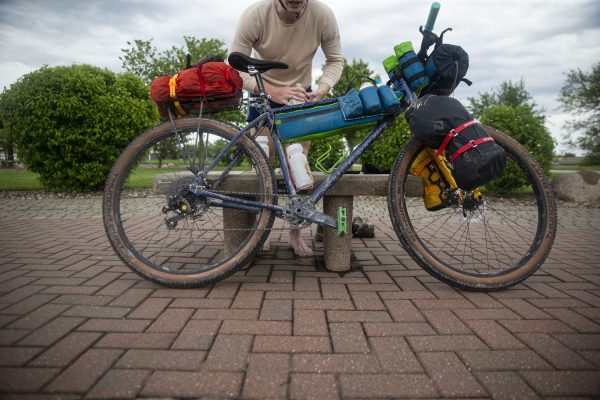
The first 15 miles were somber and gray. I rode in soaked solitude with Elijah a mile ahead and Steve a mile behind. Sayre, Ben, Carter, and Ryan decided, regrettably, to take on a gravel road instead of Highway 6, resulting in a slow arrival to Atlantic, the county seat of Cass County, Iowa.
We reunited again at a breakfast buffet in the local Hy-Vee. The air conditioning was cold on our wet skin as we shoveled eggs and pastries into our mouths. The general group attitude was low, yet a weary focus remained. We discussed the route and our overnight destination. As the rain started to fade in the east, we rode out again.
We took the T-Bone trail along the Nishnabotna River for 15 miles through sprouting fields and drooping trees. The sun peaked out of the clouds around midday as we turned back east onto scenic Highway 44 for 20 miles. The gray morning had given way to an afternoon of vibrance and clarity, reviving our group’s morale. Steve and I were ahead on our own with the rest of the group trailing behind, drafting — a technique used to decrease wind resistance — against strong southern winds.
We stopped for ice cream and pizza at Casey’s in Guthrie Center. It was there that we began to refer to our ride across Iowa as the Tour de Casey’s, and it soon became a collective joke.
While continuing on Highway 44 to Panora, Ryan began feeling nauseous and weak. Sayre and I waited for the others to catch up as Ryan stuffed his face with Gardetto's Rye Chips on the side of the road. High school graduation was in full swing as we rolled into Panora, and cars lined the front of a local high school. Some cars donned colored tassels or paint of the Panorama Panthers — blue and white.
In the late afternoon, we entered the Raccoon River River Valley Trail, another former railroad, heading towards Adel. We’d be spending the night there at Ben’s girlfriend’s family’s house. Our shadows grew long as we approached the old rail town of Redfield, less than 10 miles away from Adel. At many points the trail was undergoing construction, forcing us to make slight detours. At one point we had to hoist our bikes over a fallen tree.
“They should just make a sign that says ‘Enter at Your Own Risk’ instead of ‘Trail Closed’... [because] people are just going to enter anyway,” Ryan said.
We passed an abandoned brick factory near Redfield and were chased out of town by an old stray dog. In the last five miles to Adel, I talked to Ben about touring and how it affects our perception of material items.
“I’ve been feeling a lot more grateful for material things that I have, like a shower, my bed, and my car,” Ben said. “[Touring] forces me not to think about a lot of things… it forces me to be much more present.”
June 9 after the ride: “The whole sense of adventure that is just so present, it’s everything, it's overwhelming… when you experience that, it’s so different from what you do in your everyday life. It’s addicting,” McGuire said.
Day 3 - Monday, June 3, 2024
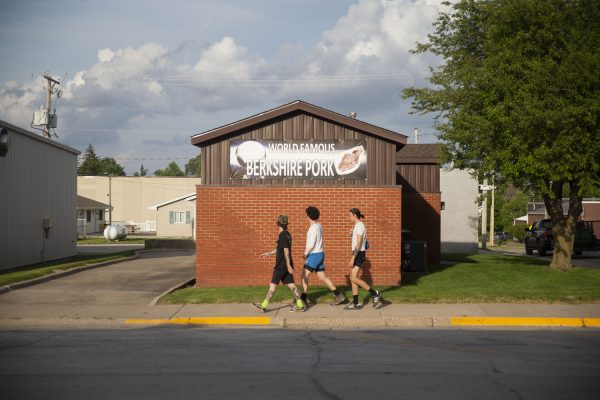
We had a slow start to the morning after eating bagels, brats, and bananas for breakfast. I feel fortunate and grateful for the group so far. The camaraderie is growing. David, another student in Steve’s class, joined us last night in Adel, so now our group sits at eight. David wears neon green and looks aerodynamic on his self-made gravel road bike. Before we start out toward Des Moines, Steve stops at Casey’s to get a Diet Coke, his preferred choice of caffeinated beverage. He tells us about his first bicycle tour, pedaling home from Iowa City to Kansas City after his first year of graduate school in the summer of 1982 when he was 24 years old. Now over 40 years later he is still touring.
“Nothing can ever bridge the gap between a person that stayed and a person who went,” Steve would tell us. We admire his experience and wisdom surrounding all things touring.
Steve and I rode through the trails around Des Moines where he told me of his adventures – past, present, and those planned for the future.
“I’m always thinking about it [touring] ... I’ll just start researching places … My aspirations are big,” he said to me. McGuire is currently planning a solo bicycle tour in Scandinavia, from Luleå, Sweden, to Alta, Norway, across the Finnish Lapland. He is projecting to cover 581 miles with over 40,000 feet of elevation gain.
As we navigated the trails that surround the southern edge of Saylorville Lake, Steve told me about how expectations often won’t match reality while on a tour.
“No matter how you imagine the day going — you plan, 'I’m going to get here, I’m going to get there' — it’s going to unfold the way it unfolds … you’re going to meet people, have conversations that change what you pay attention to; where you sleep, where you eat and those things lead to other things,” Steve said.
In Ankeny, we stopped for gas station burritos, ham sandwiches, and other food I would not eat if not for the intense pangs of hunger I felt. The sun was hot and traffic was loud. Many of the trails were under construction, and minor detours had to be made to stick to our route. Steve let me go ahead around the Chichaqua Trail, and I went off on my own to try and catch up with the other students. The trail to Bondurant was arduous yet beautiful. Garter snakes and frogs basked in the sun alongside the trail in the sitting water accumulated from the rain earlier in the week. The vegetation was vibrant and swayed with a slight wind as I continued forward.
I was reunited with the others at Sayre’s aunt’s farm in Mingo. Pork chops, potatoes, sweet corn, and green beans made for a quintessential Iowan lunch. Elijah and Carter chose to rest under a large oak tree and found themselves waving off horseflies. The rest of us talked with Sayre’s family as we waited for Steve to catch up. He arrived an hour later and accepted a meal while complimenting Sayre’s mother for the way she raised her son.
When the watermelon had been eaten and lemonade downed, we gathered ourselves to continue to Melbourne. However, after subsequent problems with Carter’s bike’s shifting, we decided that we didn’t need to push ourselves further that day. We opted for the town of Baxter — 10 fewer miles than we had originally planned. Sayre contacted his freshman roommate’s family who fortunately let us camp in their backyard. The sleepy farm town was at the end of the Chichaqua Trail and welcomed us around dusk much to the surprise of the neighbors who were mowing the lawn.
“Are you folks on RAGBRAI?” they asked.
Day 4 - Tuesday, June 4, 2024

I wake in the dark and buggy predawn around 4:00 a.m. My headlamp was red against the damp ground as I left my tent to wake up the others. “Are we going?” I ask. Elijah jerks upright. “Yeah, let’s do it,” he responds automatically. Carter and Elijah planned to leave early to push to Cedar Falls as the going was projected to be slow on gravel country with rain possibly in the forecast. Ben, Carter, Elijah, and I were on the road by 5:30 a.m. The sun’s red-orange light seeped through lazy clouds, which welcomed a peaceful morning and helped curate a hopeful frame of mind. Melbourne was 10 miles of gravel, and then we took an unmarked recreation trail northeast to Marshalltown. After sorting out navigational logistics with a local coffee shop owner, Elijah, Ben, Carter and I opted to take Wallace Avenue to Grundy Center, which proved to be faster than gravel. Steve, David, Sayre, and Ryan took the gravel.
Elijah and I picked up our pace after the small town of Beaman but rode the narrow shoulder cautiously, checking every 10 seconds for cars over our left shoulders. Trucks passed us and roared like thunder. The mangled carcasses of unlucky wildlife dotted the roadside with sometimes only bones and hide remaining. Fortunately, the traffic lessened as we pedaled further north. A short stop at Casey’s for water and to talk with the curious few who asked “So, where y'all coming from?” As we sat on the curb and waited for Carter and Ben, Elijah reflected on the journey so far, “The amount of romanticization that has grown for Iowa since [starting] the trip is exponential, I didn’t grow up in love with Iowa … but I’ve really grown a lot of respect and love for this state.” I agreed with him. I felt as though I could experience the contours of the physical geography more closely while riding my bike across the rolling landscape.
June 9 after the ride: “When you go out on an adventure [like bicycle touring], you’re forced to know things about your relationship to nature and the landscape that you otherwise wouldn’t be forced to navigate, and that gives you the ability to be a little bit more instinctive about how you interact with everything,” McGuire said.
We took the Pioneer Trail east to Reinbeck and ducked as territorial red winged blackbirds dived at our heads. The sky was overcast but did not offer any rain. We had to ride on the shoulder of a road again for a couple of miles into Hudson, where the trail just beyond led us to Elijah’s family’s place on the west side of Cedar Falls. Ben, Carter, and Elijah reminisced as we passed locations of temporal importance to them. We passed through parking lots, over bridges, and under overpasses where the somber prairie sounds of the morning had been replaced by an urban soundscape.
“Welcome to Cedar Falls,” Carter said sarcastically after biking across four lanes of traffic just to drag our bikes through a muddy construction site. After an inviting meal with Elijah’s family, we shared stories and laughs until words turned to yawns and eyelids fell heavy from exhaustion.
Day 5 - Wednesday, June 5, 2024
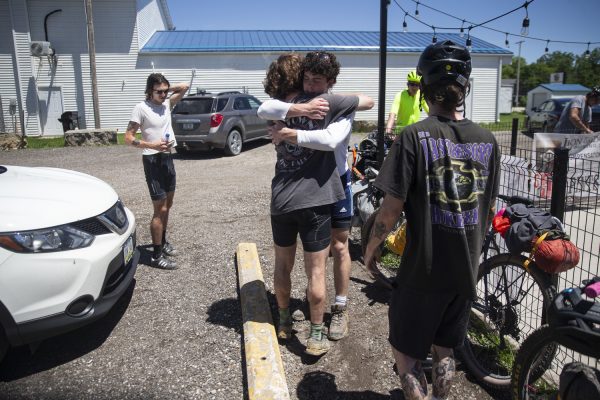
I owe my best sleep of the week to Elijah's family’s basement couch. We woke to homemade banana bread for breakfast thanks to Elijah's mom; the Cedar Falls hospitality is appreciated by all. The morning sun bounces off the Cedar River and through the trees, sprinkling the trail leading to Waterloo with golden light. The river smells deplorable yet looks delightful. Steve got the head start on us this morning but we finally caught up to him around Gilbertville. Steve laments that he wished he had a second cog so he could go faster on the 100-mile-long Cedar Valley nature trail. The gnats are thick along the trail, and large swarms hover under drooping branches of ash and oak. We pass by a sleepy snappy turtle and scornful-looking construction workers who are working on flattening sections of the trail.
Ryan cracked his frame just before midday and unfortunately decided to call it at Center Point. He is planning a bike trip in Washington State soon and needs to get back to Iowa City to weld the crack.
“Realizing that my frame was cracked … really sucked, packing my bike up and putting it in the car really hurt,” Ryan said. He rationalized his disappointment of not being able to finish out the ride by detailing to me the pending reality of his upcoming trip. “Me and two other guys are going to bike-pack the Dark Divide, which is this area in between Mt. Adams, Mt. Saint Helens, and Mt. Rainier in Washington.” Apparently, a perk of building your own bike also includes knowing how to fix it when it breaks. Within days Ryan had re-welded and reinforced his frame, exemplifying skills attained in Steve’s course.
After the ride, on June 9: “Every class begins with the question: Where do you want to ride, and how do you want to ride, and we can build that bike.” McGuire said.
The rest of us continued into Cedar Rapids without Ryan, cycling past the old Quaker Oats plant along the Cedar River. Just south of the city alongside the trail, a former landfill loomed. We decided to climb Mt. Trashmore, stopping at the top to take in the view. That’s a pretty good view for a mountain of trash, I thought. We took in the 360-degree views of the skyline as turkey vultures circled overhead. After descending the “mountain” I felt antsy to get home, and I asked David if he wanted to race to Ely. He occasionally races on gravel but “not any long ones." In Ely, David and I stopped for ice cream at Dan and Debbie’s Creamery and talked a bit about the touring lifestyle: “It’s very interesting, like you’re almost disconnected from your normal way of living, you’re not thinking about much. It’s a very simple way of living,” David said.
After the pitstop in Ely, I was solo until I met up with Steve and Sayre in Solon. Together we passed by the Solon Spartans baseball fields where a game was underway. The smell of fresh-cut grass and hotdogs wafted in our noses. By the time I made it to North Liberty, I was all alone again, accompanied only by the hiss of innumerable mating cicadas. Around dusk, I was relieved to be in my parents’ driveway.
Day 6 - Thursday, June 6, 2024
Sleeping in my own bed made it very difficult to get up this morning. My legs feel rusty. Steve’s statements rolled over in my mind.
“Nothing can ever bridge the gap between a person that stayed and a person who went.”
I personally reflected on this statement realizing that I, a "person who went," would never be the same. My perspective on the state I grew up in had changed and in doing so gave me a profound new interest in Iowa, its people, and its natural history. The relationships I was able to build with McGuire and his students also helped show me that touring with a group can add to the overall experience and that sharing a bike tour with others can be more valuable than taking on one alone.
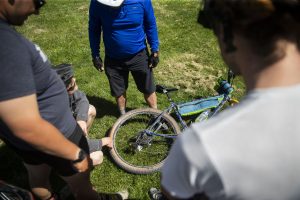
We all met at New Pioneer Food Coop to start the last day with bags under our eyes from the lack of sleep. We are down to six as Carter and Ryan have ended their journey in Iowa City. I ate some leftover banana bread from Cedar Falls and some leftover cookies from Mingo for breakfast. My bike looks naked without panniers and feels extremely light. The morning is bright and the skies clear on a rather flat expanse of gravel country. We stopped in Nichols for our last Casey’s breakfast of the tour for donuts and breakfast pizza. As I am thinking about how remarkable it is that we’ve come this far.
Sayre — who switched to one of his other hand-built bikes, based on the Velo Orange Neutrino — reached out his hand for a fist bump, “It’s an honor to have ridden with you,” he said. “Likewise,” I replied. Sayre has built three different bicycles while taking Steve’s classes. He talked about how much the class has shaped him and his college experience. “I’m so glad I had a chance to do this; it’s something I’ll look back on for the rest of my life … the memories of making this bike and what I’ve done with it, it’s all represented in that frame and the other frames I’ve built.” Sayre said. “I’m sure I could’ve met cool people in a lot of ways, but I’m glad this is the way I did.”
We are all riding together now as we descend into the Mississippi River Valley. As we approached the Running River Trail System that lines the Mississippi, fate changed the outcome of our journey. Ben dropped his wallet after going over a sidewalk curb in front of Elijah who subsequently slammed on his brakes to pick it up. As I was right behind, I couldn’t break in time to avoid a collision and hit Elijah’s derailleur quite hard, bending it into the spokes of the wheel. After carrying it 20 more meters to the riverfront, Elijah set it down, and we all gathered around it, inspecting it somberly as if it were an injured pet. After looking at the damage for a while we realized it was beyond repair. Our journey would end in Muscatine instead of Davenport.
Bittersweet faces shone brightly as sunlight reflected off the Mississippi: “Embrace fate,” Steve said, and we all agreed.
Afterthoughts
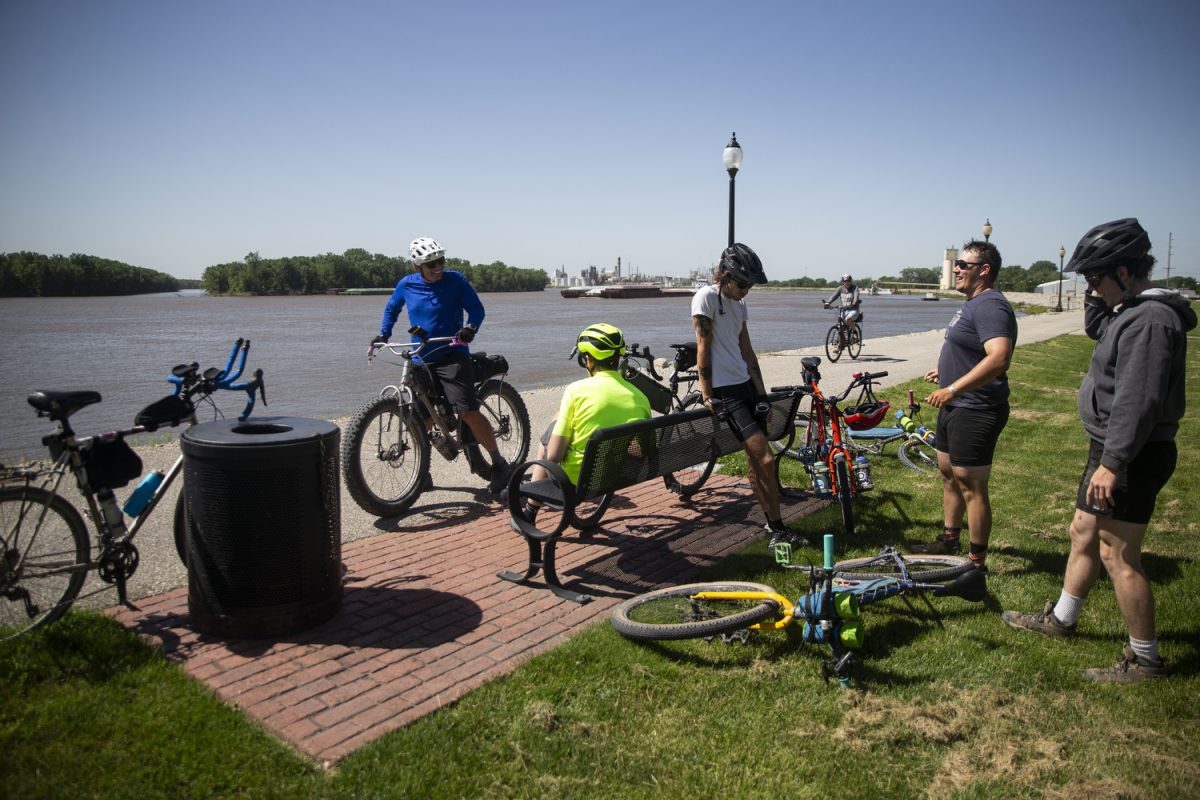
Two days after completing the tour, I went over to Steve’s house on the north side of Iowa City to talk with him about his reflections on the ride and touring in general. After sharing a meal of Pagliai's Pizza, he sat back in his chair and told me how important the tour was in terms of how he would like to leave his legacy as an instructor, mentor, and professor.
“I have begun to think about … 'OK, what do you want to leave your legacy as?' I’ve just thought, if I were 24 -25 years old and somebody could show me how to build a bike and give some pointers for how to do a trip, I would just jump at that chance. So I thought, 'This is one thing I absolutely know how to do.'” McGuire said. “I really love seeing how transformative the experience is. I just plain ass love seeing what this can do to people.”
The excitement cracks dimples in his weathered bronze skin. He tells me again about his upcoming tour in the Finnish Lapland.
“I genuinely believe that nothing can ever bridge the gap between the person who stayed and the person who went; I genuinely believe that if I go to Lapland and I do this, I’m going to create possibilities and opportunities that otherwise wouldn’t exist, and those can spill out into the rest of the world,” McGuire said.
When asked for any final reflections on the ride across Iowa, Steve paused, condensing his thoughts.
“You know, to me, this past week was actually one of the most rewarding things I’ve ever experienced … you make something — design it, build it, you go out and ride it, and then you imagine new things. You see the rise and turning over of your ideas.” McGuire said. “I actually think this is the most important lesson of the bike class. I really, really do. I think if I were going to measure the success of the course, it ultimately would be somebody doing this kind of thing, on their bike, and learning what it is to execute an adventure.”


